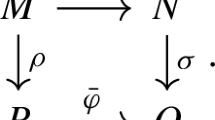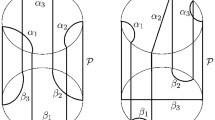Abstract
We prove that the Almgren–Pitts 6-width of the unit 3-ball is less than \(2\pi \). We also prove that there exists a free boundary minimal surface in the unit 3-ball that has genus at most 1, index at most 5, area less than \(2\pi \), and is not the equatorial disk or the critical catenoid.




Similar content being viewed by others
References
Ambrozio, L., Carlotto, A., Sharp, B.: Index estimates for free boundary minimal hypersurfaces. Mathematische Annalen 370, 1063 (2018)
Aiex, N.S.: The width of ellipsoids. Comm. Anal. Geom. 27(2), 251–285 (2019)
Almgren, F.: The homotopy groups of the integral cycle groups. Topology 1(4), 257–299 (1962)
Almgren, F.: The theory of varifolds. Mimeographed notes (1965)
Batista, M., Lima, A.: Min-max widths of the real projective 3-space. Trans. Am. Math. Soc. 375, 5239 (2022)
Brendle, S.: A sharp bound for the area of minimal surfaces in the unit ball. Geom. Funct. Anal. 22(3), 621–626 (2012)
Colding, T., De Lellis, C.: The min-max construction of minimal surfaces. Surv. Differ. Geom. 8(1), 75–107 (2003)
Carlotto, A., Franz, G., Schulz. M.B.: Free boundary minimal surfaces with connected boundary and arbitrary genus. http://arxiv.org/abs/2001.04920 (2020)
Colding, T.H., Gabai, D., Ketover, D.: On the classification of Heegaard splittings. Duke Math. J. 167(15), 2833–2856 (2018)
Chodosh, O., Mantoulidis, C.: The p-widths of a surface. arXiv preprint http://arxiv.org/abs/2107.11684 (2021)
Carlotto, A., Schulz, M.B., Wiygul, D.: Infinitely many pairs of free boundary minimal surfaces with the same topology and symmetry group. arXiv preprint http://arxiv.org/abs/2205.04861 (2022)
Devyver, B.: Index of the critical catenoid. Geom. Dedicata. 199(1), 355–371 (2019)
De Lellis, C., Pellandini, F.: Genus bounds for minimal surfaces arising from min-max constructions. J. für die reine und angewandte Mathematik (Crelles J.) 2010(644), 47–99 (2010)
Donato, S.: The first p-widths of the unit disk. J. Geom. Anal. 32(6), 1–38 (2022)
Ecker, K.: Regularity Theory for Mean Curvature Flow, vol. 57. Springer, New York (2012)
Fedja: \(\rm All\) saddles in the unit ball have area \(<2\pi \)? MathOverflow. https://mathoverflow.net/users/1131/fedja. https://mathoverflow.net/q/423592 (version: 2022-05-30) (2022)
Folha, A., Pacard, F., Zolotareva, T.: Free boundary minimal surfaces in the unit 3-ball. Manuscripta Math. 154(3), 359–409 (2017)
Franz, G.: Equivariant index bound for min-max free boundary minimal surfaces. http://arxiv.org/abs/2110.01020,(2021 (2021)
Fraser, A., Schoen, R.: The first Steklov eigenvalue, conformal geometry, and minimal surfaces. Adv. Math. 226(5), 4011–4030 (2011)
Fraser, A., Schoen, R.: Sharp eigenvalue bounds and minimal surfaces in the ball. Invent. Math. 203(3), 823–890 (2016)
Guang, Q., Li, M.M., Wang, Z., Zhou, X.: Min-max theory for free boundary minimal hypersurfaces II: general morse index bounds and applications. Math. Ann. 379(3), 1395–1424 (2021)
Hatcher, A.: A proof of the Smale conjecture. Ann. Math. 117, 553–607 (1983)
Kapouleas, N., McGrath, P.: Generalizing the Linearized Doubling approach, I: General theory and new minimal surfaces and self-shrinkers. http://arxiv.org/abs/2001.04240 (2020)
Kapouleas, N., Zou, J.: Free boundary minimal surfaces in the Euclidean three-ball close to the boundary. arXiv preprint http://arxiv.org/abs/2111.11308 (2021)
Ketover, D.: Equivariant min-max theory. http://arxiv.org/abs/1612.08692 (2016)
Ketover, D.: Free boundary minimal surfaces of unbounded genus. http://arxiv.org/abs/1612.08691 (2016)
Ketover, D.: Genus bounds for min-max minimal surfaces. J. Differ. Geom. 112(3), 555–590 (2019)
Kapouleas, N., Li, M.M.: Free boundary minimal surfaces in the unit three-ball via desingularization of the critical catenoid and the equatorial disk. http://arxiv.org/abs/1709.08556 (2017)
Kapouleas, N., Wiygul, D.: Free-boundary minimal surfaces with connected boundary in the \(3 \)-ball by tripling the equatorial disc. http://arxiv.org/abs/1711.00818 (2017)
Li, M.M.: A general existence theorem for embedded minimal surfaces with free boundary. Commun. Pure Appl. Math. 68(2), 286–331 (2015)
Li, M.M.: Free boundary minimal surfaces in the unit ball: recent advances and open questions. In: Proceedings of the International Consortium of Chinese Mathematicians, 2017 (First Annual Meeting), pp. 401-436, 654. International Press of Boston, Inc (2020)
Liokumovich, Y., Marques, F.C., Neves, A.: Weyl law for the volume spectrum. Ann. Math. 187(3), 933–961 (2018)
Lyusternik, L.A., Schnirelmann, L.G.: Topological methods in variational problems and their application to the differential geometry of surfaces. Uspekhi Matematicheskikh Nauk 2(1), 166–217 (1947)
Li, M.M., Zhou, X.: Min-max theory for free boundary minimal hypersurfaces I: regularity theory. J. Differ. Geom. 118(3), 487–553 (2021)
Marques, F.C., Neves, A.: Min-max theory and the Willmore conjecture. Ann. Math. 179, 683–782 (2014)
Marques, F.C., Neves, A.: Morse index and multiplicity of min-max minimal hypersurfaces. Camb. J. Math. 4, 463 (2016)
Marques, F.C., Neves, A.: Existence of infinitely many minimal hypersurfaces in positive Ricci curvature. Invent. Math. 209(2), 577–616 (2017)
Marques, F.C., Neves, A.: Morse index of multiplicity one min-max minimal hypersurfaces. Adv. Math. 378, 107527 (2021)
Nurser, C.A.G.: Low min-max widths of the round three-sphere. PhD thesis, Imperial College London (2016)
Pitts, J.: Existence and Regularity of Minimal Surfaces on Riemannian Manifolds (MN-27), vol. 81. Princeton University Press, Princeton (2014)
Sargent, P.: Index bounds for free boundary minimal surfaces of convex bodies. Proc. Am. Math. Soc. 145(6), 2467–2480 (2017)
Schulz, M.B.: Geometric Analysis Gallery, Free boundary minimal surfaces with connected boundary
Smith, F.: On the existence of embedded minimal 2-spheres in the 3-sphere, endowed with an arbitrary Riemannian metric. Doctoral dissertation (1982)
Sun, A., Wang, Z., Zhou, X.: Multiplicity one for min-max theory in compact manifolds with boundary and its applications (2020)
Smith, G., Zhou, D.: The Morse index of the critical catenoid. Geom. Dedicata. 201(1), 13–19 (2019)
Tran, H.: Index characterization for free boundary minimal surfaces. Comm. Anal. Geom. 28(1), 189–222 (2020)
Tomoda, S., Zvengrowski, P.: Remarks on the cohomology of finite fundamental groups of 3-manifolds. Geom. Topol. Monogr. 14, 519–556 (2008)
Zhou, X.: On the multiplicity one conjecture in min-max theory. Ann. Math. 192(3), 767–820 (2020)
Zhu, J.J.: Widths of balls and free boundary minimal submanifolds. http://arxiv.org/abs/2203.10031 (2022)
Acknowledgements
The author is very grateful to his advisor André Neves for the constant support and patient guidance throughout the progress of this work. He would also like to thank DeVon Ingram, Daniel Mitsutani, Chi Cheuk Tsang, and Ao Sun for the helpful conversations, and fedja regarding the proof of Proposition 3.5. He also thanks Danny Calegari for his comments.
Author information
Authors and Affiliations
Corresponding author
Additional information
Publisher's Note
Springer Nature remains neutral with regard to jurisdictional claims in published maps and institutional affiliations.
Appendices
Appendix A: Proof of Proposition 3.5
The following proof is due to the MathOverflow user fedja [16]. Let M denote the saddle in \({\mathbb {R}}^3\) given by \(x^2-y^2+z=0\). Then to prove Proposition 3.5, it suffices, by rescaling, to show that for any ball B with center \((x_0,y_0,z_0)\) and radius \(R>0\), the area of \(M\cap B\) is less than \(2\pi R^2\).
Recall that M is foliated by straight lines: It can be parametrized by \(\textbf{x}(s,t)=(s+t,s-t,4st)\). Then the Jacobian of \(\textbf{x}\) is \(2\sqrt{1+8s^2+8t^2}\). Thus we have
Now, for each fixed s, let \(L_s\) be the corresponding coordinate line segment in \(M\cap B\). Letting d be the distance between \(L_s\) and the center of B, we have
Note that \(L_s\) is parameterized by a time interval of length
where \(^+\) denotes the positive part. It follows that, using (21) and (22),
The second integral in (20) can be similarly bounded, by integrating with respect to s first. So \(\textrm{area}(M\cap B)<2\pi R^2\), finishing the proof of Proposition 3.5.
Appendix B: First Variation Formula
Lemma B.1
Let \(\Omega \) be a compact \((n+1)\)-dimensional region with smooth boundary in \({\mathbb {R}}^{n+1}\), \(\{\Sigma _s\}\) a 1-parameter family of hypersurfaces without boundary in \({\mathbb {R}}^3\), and V a deformation vector field of \(\{\Sigma _s\}\). Then
where \(\textbf{n}\) is a chosen unit normal vector field of \(\Sigma _s\), w the outward unit normal of \(\partial \Omega \), and \(\nu \) the outward unit conormal of \(\Sigma _s\) on \(\partial \Omega \).
Proof
We first smoothly extend w to a unit vector field on a neighborhood of \(\partial \Omega \) in \(\Omega \), and \(\nu \) to a unit tangent vector field on a neighborhood of \(\partial \Sigma _s\) in \(\Sigma _s\). Let \(\epsilon >0\), and \(\Omega _\epsilon \subset \Omega \) be where the distance from \(\partial \Omega \) is at least \(\epsilon \). Then by using the function \(\textrm{dist}(\cdot ,\partial \Omega )\) on \(\Omega \), with suitable smoothening, we can approximate the indicator function \(\chi _\Omega \) by a smooth function \(\chi ^\epsilon _\Omega \) that is 0 outside \(\Omega \) and 1 on \(\Omega _\epsilon \), with \(\nabla \chi ^\epsilon _\Omega =-|\nabla \chi ^\epsilon _\Omega |w\) in between.
Now, using the first variation formula (4.2) in [15, p.49],
Note that
Denoting \(g:=\frac{w\cdot \textbf{n}}{w\cdot \nu }\; V\cdot \textbf{n}\), we then have
in which the second and the third equality are due to divergence theorem. Hence, \(\frac{d}{ds}\textrm{area}(\Sigma _s\cap \Omega )\) is equal to
\(\square \)
Appendix C: A Lemma About Cubic Polynomials
Lemma C.1
There exists \(h>0\) such that the following is true. For any a, b, c such that \(a^2+b^2+c^2=1\), define \(f:[-\frac{1}{2}, \frac{1}{2}]\rightarrow {\mathbb {R}}\) by \(f(x)=ax^3+bx+c\). Then there exists some interval of length \(\frac{1}{8}\) in \([-\frac{1}{2},\frac{1}{2}]\) on which \(|f|>h\).
Proof
Assume, by contradiction, that for each positive integer n there exists a cubic function \(f_n(x)=a_nx^3+b_nx+c_n\), with \(a^2_n+b^2_n+c^2_n=1\) such that there is no interval of length \(\frac{1}{8}\) in \([-\frac{1}{2},\frac{1}{2}]\) on which \(|f|>\frac{1}{n}\). For each n, let \(x_i\), for i runs from 1 to at most 3, be the roots of \(f_n(x)=0\), and \(I_i\subset [-\frac{1}{2},\frac{1}{2}]\) be the maximal interval containing \(x_i\) on which \(|f_n|<\frac{1}{n}\). Then \([-\frac{1}{2},\frac{1}{2}]\backslash (I_1\cup I_2\cup I_3)\) is a union of at most 4 intervals, each of which has length at most \(\frac{1}{8}\). Thus, \(I_1\cup I_2\cup I_3\) has length at least \(1-4\cdot \frac{1}{8}=\frac{1}{2}\), and on it \(|f_n|<\frac{1}{n}\). Then it follows easily that \(\sup _{x\in [-\frac{1}{2},\frac{1}{2}]}|f'_n(x)|\rightarrow 0\) as \(n\rightarrow \infty \). Since \(f'_n(x)=3a_nx^2+b_n\), we must have \(a_n\rightarrow 0\) and \(b_n\rightarrow 0\) too, which forces \(c_n\rightarrow 1\) since \(a^2_n+b^2_n+c^2_n=1\). But then \(f_n\) is very close to 1 on \([-\frac{1}{2},\frac{1}{2}]\), contradicting that \(|f_n|<\frac{1}{n}\) on a set of length at least \(\frac{1}{2}\). \(\square \)
Rights and permissions
Springer Nature or its licensor (e.g. a society or other partner) holds exclusive rights to this article under a publishing agreement with the author(s) or other rightsholder(s); author self-archiving of the accepted manuscript version of this article is solely governed by the terms of such publishing agreement and applicable law.
About this article
Cite this article
Chu, A.CP. A Free Boundary Minimal Surface via a 6-Sweepout. J Geom Anal 33, 230 (2023). https://doi.org/10.1007/s12220-023-01285-y
Received:
Accepted:
Published:
DOI: https://doi.org/10.1007/s12220-023-01285-y




